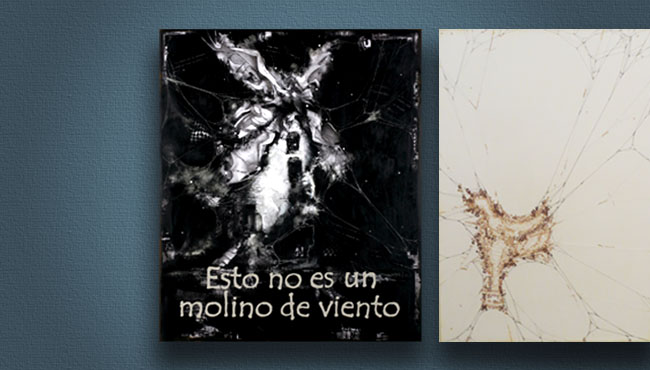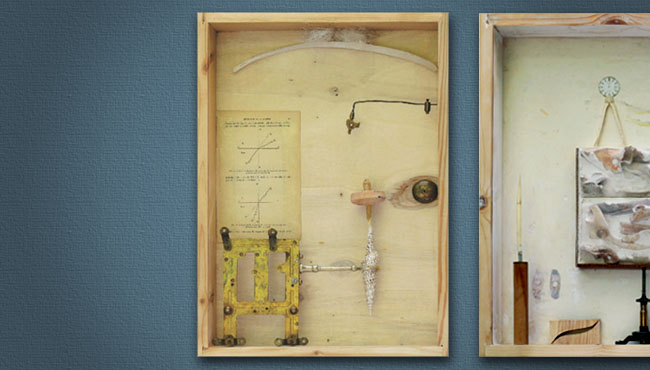Don Quixote said: “It is obvious, you are not aware of the heroic adventures, I’m telling you these are ferocious giants. If you are afraid, go off to one side say your prayers while I am in an unequal and frightening battle with it.” And after saying these words without paying attention to advices by his squire Sancho, who was yelling at him: “Have some mercy! They are truly windmills, and not giants”, he gave spurs to his steed “Rocinante.” The giant-ness of the windmills was inscribed on Don Quixote’s soul in such a way that not only he could not hear his squire Sancho shout but he could not find out what they really were, when he approached the windmills. Just contrary, while he was galloping on, he was shouting: “Do not seek to flee, you ugly and vile creatures! Now it is only a single knight with whom you have to deal!”
Don Quixote is the title of a group exhibition organized by Behnam Kamrani at Aan Gallery. Behnam Kamrani, Babak Emanuel, Krista Nassi, Adel Younesi, Negar Farjiani, Peyman Pajouhan, and Pantea Karimi showcased their works in this exhibition. Don Quixote by de Cervantes, a 16th and 17th century author, is the narrative of a symbolic and ironic nobleman who is struck with an amalgamate of illusion, paranoia, and saving the world after reading some heroic and chivalric novels – at a time when these traditions are over – and places his emaciated body on a horse and sets out to “take revenge for the violence, try to do away with the cruelties, make up for the oppressions, hinder the assaults, and settle for everything.” This is a novel, whose psychological, philosophical, and social aspects are not limited to a specific time or place, but is a familiar and repetitive myth in our biogeography.
This exhibition had many features which made it stand out: Firstly, participation of three Iranian-origin artists who are residing abroad made the atmosphere of the works different from what we usually see in galleries. Focusing on technique, artists had created more refined and mature works, an achievement which undoubtedly is the result of the Western academic and professional world, which trains artists through accuracy and efficiency. The second strong point of this collection is the creation of works ordered by the organizer, not based on the works which are already created by the artist. This trend is the basis for professional curatoring activities and is often ignored in our country and leads to incorrect, inaccurate, and irrelevant choices or choices which are loosely tied to the theme of the exhibition. There number of artists who participated in this exhibition was low and each artist presented at least two and at most eight works. This caused cohesion and prevented visual dispersion of the works, even though the unprofessional handling of the gallery on the opening day and not preparing artists’ name tags on the works is something we cannot ignore. Babak Emanuel is an Iranian-origin US artist who presented four of his works in this exhibit which are considered outstanding and prominent in terms of technique and conceptual approach. In two of his works, entitled “Dialogue One” and “Dialogue Two” he has shown Don Quixote dialogues on the surface of his steed’s packsaddle in an intertwined manner and relief print. In the other work, his squire Sancho’s dialogues are shown on his steed’s packsaddle. By sticking some cuts on the canvas, he has also activated the negative atmosphere and has established a proper connection to the main theme. These two works are unique in terms of cutting technique. In Babak Emanuel’s other work, William Shakespeare and de Cervantes find a common point in a number, despite all the differences in their styles. April 23rd, 1616 is said to be the day both authors passed away. An arrow and a feather are placed on top of the canvas as a symbol of the two authors. In another work by him entitled “This Is Not a Windmill”, this sentence is written in Spanish on canvas. On one hand, this sentence is a reference to the art historical work “This Is Not a Pipe” by René Magritte, and on the other the illusion-stricken mind of Don Quixote is depicted in the form of cobweb-like interwoven structures in a surrealistic or even horrifying atmosphere. In this work the artist’s manual designs are covered with a layer of paraffin and printing black ink as well and he has unburied the design by erasing parts of the work. The black atmosphere of the work alongside the non-typographical writing in big size and also erasing some parts and leaving other parts untouched, represents Don Quixote’s atmosphere of suspicion and paranoia very well. In Pantea Karimi’s small-sized works which were created by a combination of silk print, watercolor and pencil on cardboard Don Quixote comes to Iran and his steed is one of the horses in Iranian paintings and in an equivocal dialogue he touches on some events in the Iranian history. Karimi’s post-modern view in this series, namely the humorous meeting of the past and present, has served the purpose for the main theme of this exhibition. Krista Nassi has also replaced the common digital print with the Salvage technique and consequently the image sits well on the canvas. In a video by Behnam Kamrani, however, we are faced with Don Quixote’s steed in the beginning which looks like a local horse with the familiar accessories on a dry land and looks in a noble and sorrowful manner into the camera. Then we see Don Quixote with the stature of a black-clad man with local clothes on the horse. The hero, who is not an authentic hero, is mounted on the crooked, skinny horse and fantasizes his heroic journey. Negar Farjiani’s works, however, is not so relevant to other works in terms of style and the manner of expression. Peyman Pojhan’s installation is the most symbolic work in this exhibition. He introduces Don Quixote as the symbol for a template thinking which views the world through this framework: The Iranian rug, instead of being rolled, is formed into cuboid-like structure and a space filled with Farsi letters in different handwritings as a traditional symbol of speech embraces that: the main thinking in this work is incorporating symbolism and a non-human element mounted on the steed as a character representing Don Quixote which indicates his deep view. Of course, using the thread-bare Iranian symbol of rug has diminished the creativity and success of the work.
More than being a literary figure, Don Quixote is a cultural phenomenon. This is the view which has led to creation of comic characters such as “Dayi Jaan Napel’on” (Uncle Napoleon) in Persian literature whose conflicts with imaginary enemies and his suspicion towards the insiders and outsiders has turned into a theme for social comedy genre. This exhibition also aims to depict this theme in different angels and in the form of different media.
Mahsa Farhadikia

